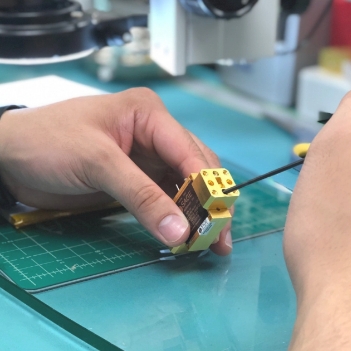One way of measuring the millimeter wave’s ability to penetrate is to compare it with another common electromagnetic wave that we all know – the light wave. How can a wavelength penetrate an object when objects are transparent? How can a certain shape be made opaque or transparent by a certain wave? These are some questions that will be answered shortly.
What is Extremely high frequency:
Extremely high frequency (EHF) is the International Telecommunication Union classification for the band of electromagnetic waves in the visible electromagnetic spectrum from thirty to 300 GHz. It lies right between the ultra-high frequency (UHF) band and the far-infrared band, and the lowest portion of which is the tera-hertz band. In the previous decades, many telecommunications engineers and scientists had predicted the existence and the future applications of such a band. However, until recently, no one had been able to see a clear signal even with the help of a very powerful satellite.
Why millimeter wave is the future:
The millimeter wave is predicted to become the next invention that will make communication easier, faster and safer in our daily lives. Although, it is already widely used in telephones and other electronic devices. This wave is already used in medicine and electronics. Currently, mobile phones use the mmwave spectrum. It has also been proposed to introduce this into the global marketplace as early as 2021.
Aside from the benefits in terms of efficiency and speed, another major advantage offered by the millimeter-wave is its high frequency. This means that it transmits better signals compared to other wireless technology available in the market. For instance, using the UHF band requires a greater energy consumption. However, if you use the millimeter-wave, you will experience a significant improvement in your data transmission speed. This means that you will enjoy faster Internet connections at lower data rates.
The millimeter-wave has the ability to operate in any wireless environment. It operates at two different wavelengths: the lower wavelengths or the alpha waves are below the audible frequency and can only be detected by the human eyes. Meanwhile, the higher wavelengths are above the audible frequency and can be detected by the human eye. The latter type of waves can carry voice and data easily at very high frequencies.
Benefits of Millimeter Wave Products
Some benefits offered by the millimeter waves include: better thermal emission, non-coustic imaging systems, and better image resolution. These benefits were discovered after observing how thermal emission occurs at different frequencies. From the observations, it was realized that the emitted sound waves are produced by objects at high temperatures. By determining the temperature difference between the hot and cold air masses, scientists were able to identify the existence of millimeter waves.
Five G Cellular Antenna System
With the help of the five g cellular antenna system, researchers were able to use this technology for better high-frequency imaging systems. They were able to record images of active tissues at high temperatures. The highest frequency of which these images can be recorded is around 2.4 GHz. The higher the frequency, the clearer the images would be.
Transmit voice signals
The ability of the millimeter waves bands to transmit voice signals at a much higher frequency enabled researchers to make telephones with voice communication capabilities. These phones do not have to be very large as compared to current telephones. Additionally, they have a much larger bandwidth since they operate at a lower frequency. As a result, there is no loss of audio clarity when transferring data from one source to another.
Point-to-point communications spectrum
When it comes to the point-to-point communications spectrum, millimeter waves cover a large portion of this spectrum. In fact, their range is almost as wide as the wavelength between the sun and the earth. This makes them ideal for point-to-point links, which have significant applications in various industries. They can transfer data at high directivity frequencies, which have good signal to noise ratio. The greater the frequency of transmission, the better the quality of the signal.
Point-to-Point Links
Mention was also made of the passive systems that utilize the millimeter waves for point-to-point links. There are two types of these systems. One uses a low level of passive wave propagation and the other uses an atmospheric attenuation technique. Passive systems work well in a wider spectrum of temperatures, whereas the atmospheric attenuation technique can only work at a certain temperature. The latter technique works best in lower frequencies and is more appropriate for use in low Earth orbit satellites. It can also be used for point-to-point links where the bandwidth is limited.
Satellites system
For satellites in geostationary orbit, where there is little atmosphere and little fluctuation in temperature, the passive techniques can work quite well. But, in low Earth orbit, where there is a large variety of possible frequencies to operate on, e-band communications are more suitable. The millimeter wave has enabled engineers to design systems that can operate at higher bandwidths, using simpler technologies than had been possible before. In other words, with the help of modern technologies such as fiber optic fibers and radio frequencies, engineers are now able to handle very high throughput speeds. With the widespread use of the e-band technologies in telecommunications, it is expected that bandwidth limits will start to disappear in the future.



